What is Strategy Implementation?
Strategy implementation is the process used to ensure a strategic plan is executed. It involves translating the high-level goals and objectives outlined in a company's strategic plan into specific actions and initiatives that can be carried out by employees at all levels of the organization.
As a whopping 9 out of 10 organizations fail to implement their strategies, you can’t just create a strategic plan and leave it on the shelf—make sure you have a solid strategy implementation process in place to bring it to life.
In our six-step strategy implementation process, you will transform your static, inactive plan into a living, dynamic, and successful strategy implementation. Read our article on factors affecting strategy implementation to develop an even deeper understanding of strategic implementation.
6-Step Strategy Implementation Process
The implementation process should follow a strategic analysis and strategy formulation phase. After you’ve identified your business problem and strategy to tackle it, you should follow these key steps to put your strategy into action:
- Choose your strategy framework
- Build your plan
- Define projects and KPIs
- Establish your strategy rhythm
- Implement strategy reporting
- Link performance to strategy
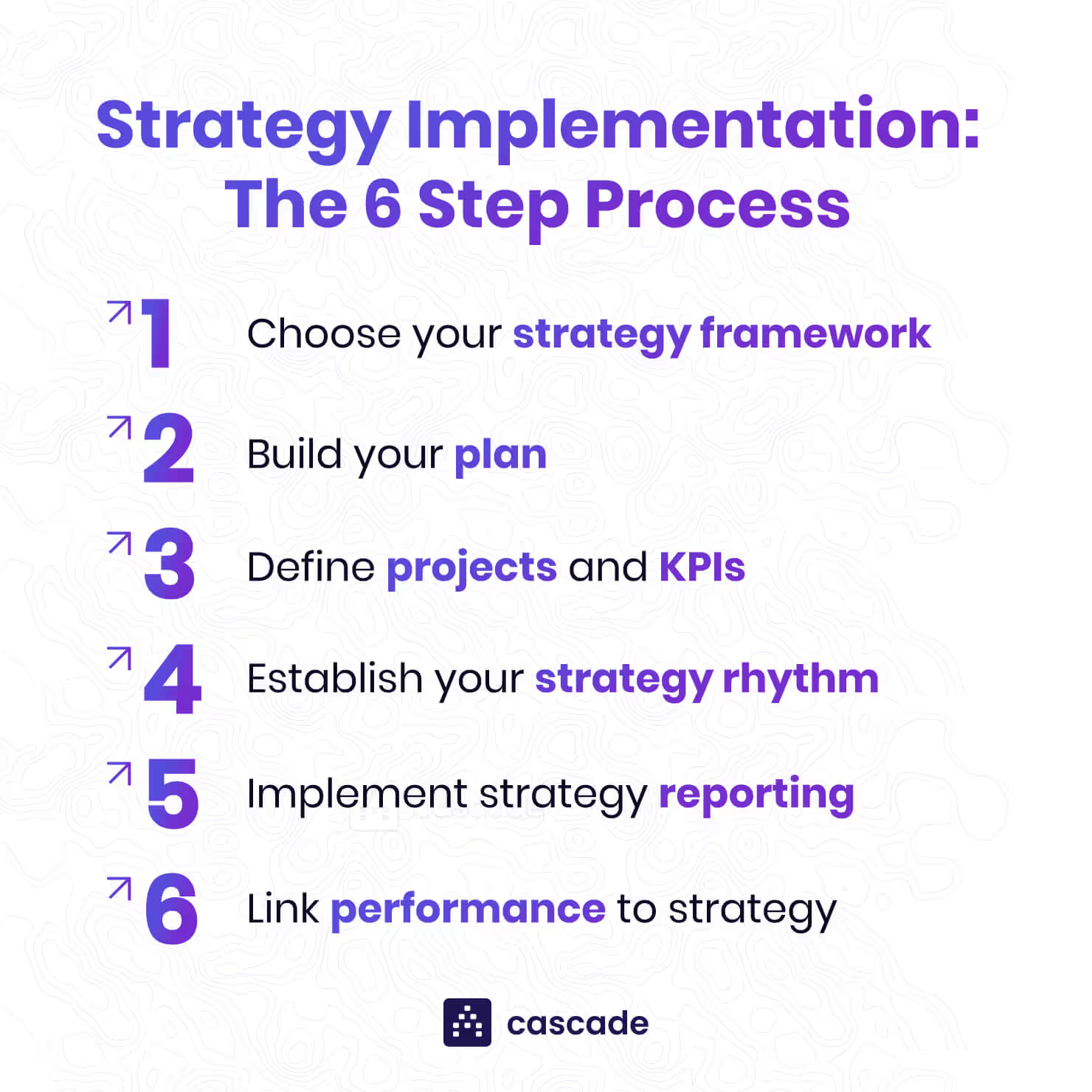
Here is our 6-step process guide to strategy implementation to ensure your new strategy evolves from a plan to strategic implementation.
Step #1: Choose your strategy framework
Strategy is something that should be embedded in everything an organization does.
It must be part of the DNA of both the organization and its people. But if you don't make an effort to call it out explicitly, you won't get the focus or traction you need.
Start with a simple framework that establishes a strategy lexicon everyone understands and can get behind. Whenever someone asks, "how are our strategic objectives going?", everyone must be on the same page regarding what it actually means.
For example, at Cascade, we use the following "strategy house" to define the different elements of our strategy:
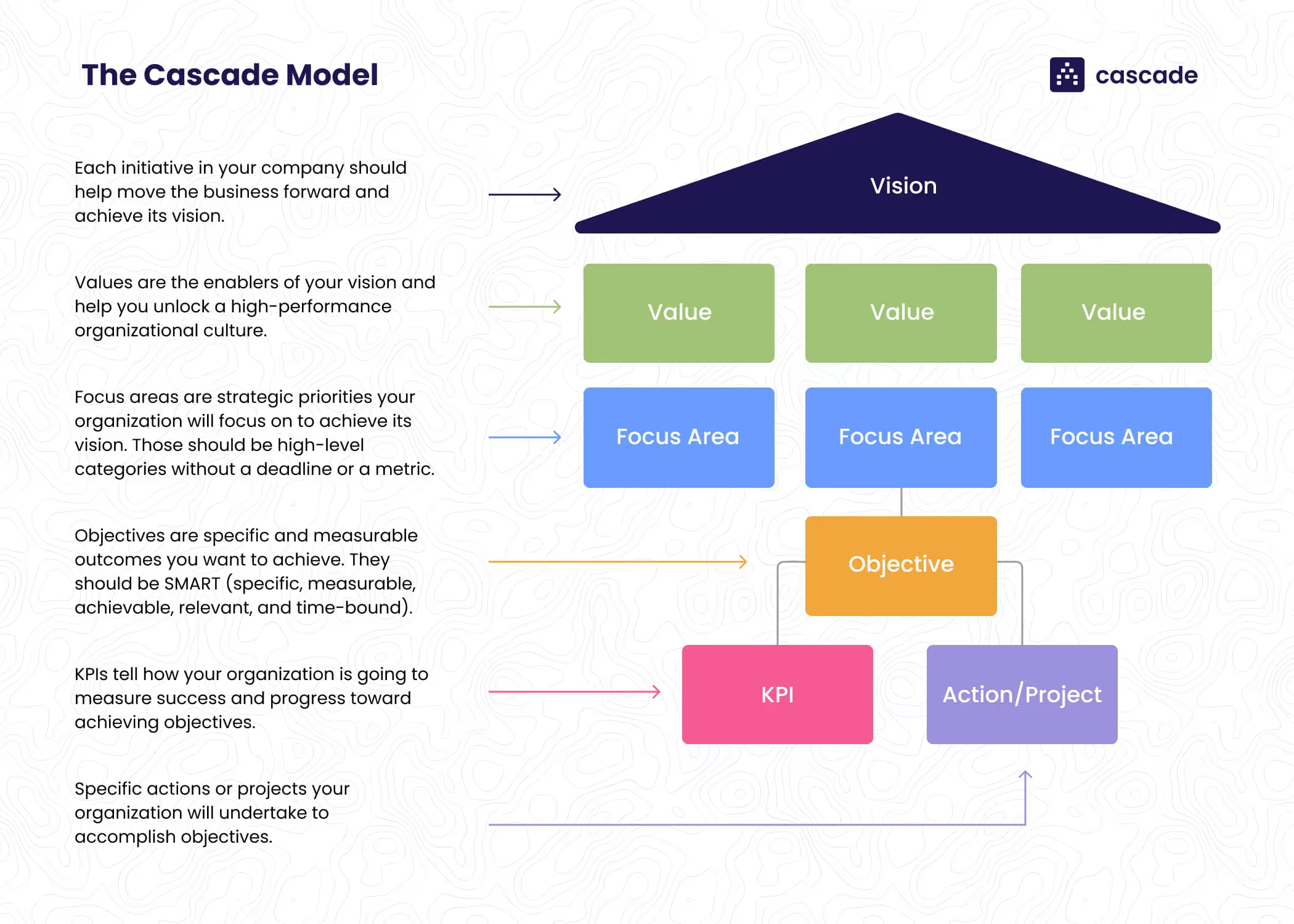
We walk you through this approach in our How to Write a Strategic Plan Guide, where you’ll also find a free template you can download to jump-start the development of your strategy.
It gives you a clear way to talk about strategy implementation and avoids using unnecessary jargon.
We've deliberately chosen to include only a vision statement rather than the more popular “vision and mission” combo because we found that people struggle to understand the difference between those two.
If you need to add more depth to your strategy, consider using a strategic planning framework such as the Balanced Scorecard or McKinsey's Strategic Horizons.
However, whichever strategic framework you choose, simplicity should remain your top priority. All of the frameworks in our guide pass this test with flying colors!
Step #2: Build your plan and set clear goals
The next step of our strategy implementation process is where you start creating your roadmap to success.
Now that you've got your framework in place, you're ready to move on to the actual creation of your strategic plan. We've developed a comprehensive guide on how to write a strategic plan, so we won't go into details here.
But assuming you're using a framework similar to the one above, here's how we'd suggest approaching the creation of your implementation plan with your key stakeholders:
1. Bring together your management team: Gather the leaders of your organization (founders, CEO, directors, etc.) to agree on your vision. You might do this in one workshop but have them engaged with it regularly. Have them read this article to keep everyone on the same page.
2. Define values: At the same workshop, write down the values that the organization holds. They’re crucial for your company’s culture, so go through this article to make the process smoother.
3. Align on strategic priorities: Finally (same workshop still), write down 3 or 4 Strategic Focus Areas the team thinks need to be addressed to reach the vision.
4. Co-create objectives with your teams: Take your basic framework back to your team(s) and have them independently input ideas for strategic goals and objectives under each Focus Area. You must involve them in the planning process and give them a voice. This will ensure buy-in and motivation to implement your business strategies.
💡Tip: You might want to assign one Focus Area to each member of your leadership team and have them lead the charge for getting that Focus Area fleshed out. This is a great way to ensure buy-in to the final product of your strategic plan.
📚Recommended read: The Right Way To Set Team Goals
5. Make a final check: Once you've fleshed out the strategic objectives, get back together as a group and ask yourself a series of hard questions:
- If we deliver each of these strategic objectives under a given Focus Area, will we have nailed that Focus Area?
- If we deliver all of our Focus Areas, will we reach our vision?
- Will our values help or hinder us along the way?
📚Recommended read: How To Effectively Co-create Strategy At Your Organization (Summary and recording of the workshop with Illana Rosen, Director of Innovation and Strategy at Old Navy)
Step #3: Define KPIs and projects
Now it’s time to cover the bottom layer of our strategy house: projects and key performance indicators (KPIs).
That's part of the strategy implementation process where top management should empower people throughout the organization to come up with their projects and KPIs to measure success.
Step 3 of our process guide to strategy implementation is to define your KPIs and create effective projects. You need actionable steps (projects) and a way to measure progress toward your strategic objectives (KPIs).
KPIs
KPIs are one of the oldest management tools around. And for a good reason—they work. They keep you and your team members honest about progress and focused on outcomes.
They need to become your beacons for implementing strategy. Here are a few tips when it comes to coming up with your own:
- Keep them simple: Don't try to come up with complex ratios that only a small group of people understand. Make them simple and relatable to everyone in the organization.
- Choose at least 1 KPI for each of your strategic objectives: In general, it’s best to have 1-3 KPIs per objective. Too many KPIs can lead to confusion and dilute focus. However, the exact number will depend on the complexity of the objective and available resources. If an objective is particularly complex, it may require more KPIs to adequately measure progress.
- Make it easy to measure them quickly: Large organizations have hundreds of metrics, with each unit and function tracking them in their own set of preferred tools and applications. Bring them under one roof so you can get real-time insights.
- Don't make them all about the $$$: Sure, profit and revenue might be your end-game, but KPIs should be the drivers of those things—measuring the outcomes alone adds little value.
Here’s an example of focus areas, related strategic objectives, and assigned KPIs:
Focus area: Operational Excellence
Strategic objective: Reduce waste in the manufacturing process by 15% within the next year
KPIs:
- Scrap rate: Measures the percentage of defective products or materials that are discarded during the manufacturing process.
- Overall Equipment Effectiveness (OEE): Measures the overall efficiency of manufacturing equipment.
- Cycle time: Measures the amount of time it takes to complete one unit of production.
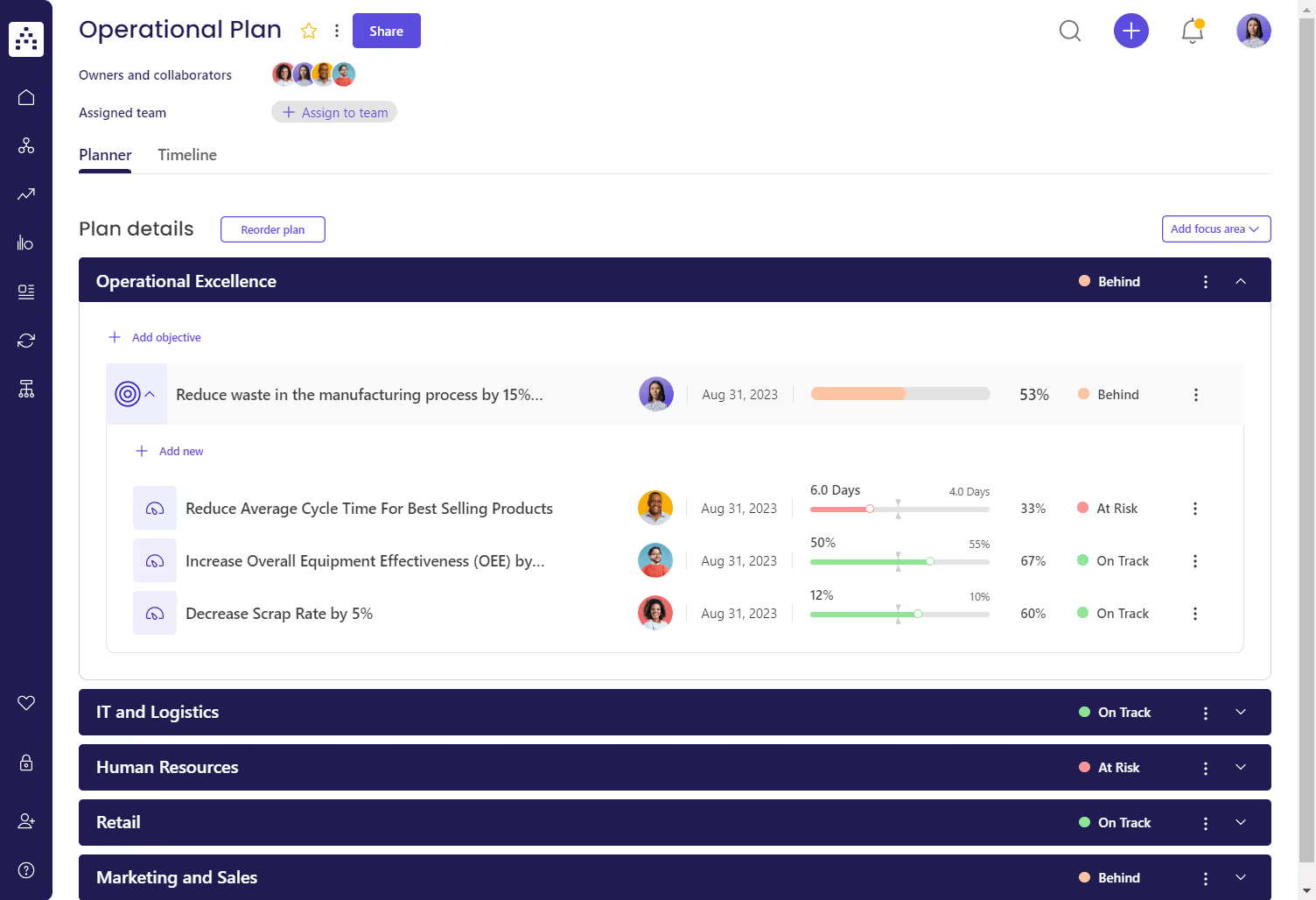
One final point: You need to update the progress of your KPIs at least once per month, or you risk quickly losing focus on them. Spend the time now as part of your strategic planning process to figure out how to access the stats and data you need.
Projects
Projects are the specific initiatives and actions that will help the organization achieve its strategic goals. Here are some steps to create effective projects in the strategy implementation process:
- Make sure your projects are aligned with your overall business strategy.
- Prioritize the projects that will have the most significant impact, and define specific project objectives that are SMART (specific, measurable, achievable, relevant, and time-bound).
- For each project, you should have a detailed project plan that includes timelines, milestones, and key stakeholders.
- Assign teams with the right skills and knowledge to execute the project, monitor progress, and adjust as needed.
- Once the project is complete, hold a retrospective meeting. Evaluate the outcomes, identify successes and areas for improvement, and use this information to inform future projects.
📚Recommended read: Free Implementation Plan Templates And Examples
Step #4: Deal with business-as-usual
Step 4 in our guide to strategy implementation is where you overcome business-as-usual.
The ironic thing about strategy implementation is that everyone acknowledges its importance, but it's often the first thing to be forgotten about when the going gets tough.
People get so caught up in the day-to-day that they don't have time to focus on the big-picture items that will keep the organization moving forward. This rapidly becomes a self-fulfilling cycle and is one of the most common reasons strategies fail.
Here are some tips to help you break the cycle:
- Meet often to discuss progress: We'd suggest a minimum of quarterly reviews for higher-level objectives, but monthly would be a great place to start until things get bedded in.
- Determine the attendees: You'll need the leadership team at a minimum—but you also need to involve the rest of the organization. The more they engage with the overall strategy, the stronger the ownership they feel.
- Be conscious of time: Specify the end time and always respect it. Allocate the last 10 minutes (or as many as you need) to “next steps”. Reviewing progress without the next steps is meaningless.
- Define the meeting structure beforehand: What metrics will you discuss? For how long? Which reports will be used? More on this in step #5 below.
Step #5: Implement consistent & simple strategy reports
Step 5 of our process guide to strategy implementation focuses on strategy reporting.
Once you've put your strategy into action, it's important to review and adapt it regularly to ensure it's still on track to meet your business goals. This is where strategy reports come in handy.
Now that your meetings are in place, you'll want to choose a consistent way of reporting the progress of your strategy implementation. The main objectives of this report should be:
Consistency
Set up a regular schedule for reviewing your strategy reports. This could be weekly, monthly, or quarterly—whatever works best for your business. Everyone should know what to expect and what they need to update before the meeting(s).
Simplicity
The progress report should give an at-a-glance view of how the strategy is progressing. Identify the key metrics that are most important to your business, and focus on those when reviewing your reports and dashboards.
Accountability
Ensure that the report includes the names of the owner of each goal (accountability), as well as the names of the people getting things done (recognition).
Conclusions
Your next steps. Your action plan. What will be done to get to desired outcomes? The strategy report needs to include not only an overview of how the strategy looks now but how it's progressing over time. Try to include a comparison period or graphs/charts that show progress over time to ensure momentum is maintained.
Strategy reports will help you look for trends and patterns in your data. Are there areas where you're consistently exceeding expectations? Are there areas where you're consistently falling short? Use this information to make informed decisions about how to adapt your strategy.
And don't forget - adapting your strategy doesn't mean giving up on it entirely. It simply means making adjustments and tweaks to ensure you're staying on track and achieving your goals. Sometimes, a small tweak can make a big difference in your results, so don't be afraid to make changes as you go.
👉 How Cascade can help you:
You should be able to create, customize, and share strategy reports with your team with ease. Even if you are not a professional business data analyst. That’s where Cascade comes in.
With a user-friendly interface, you’ll be able to stay organized and focused on your strategic goals.
.png)
But you’ll be able to do more than just create progress reports; Cascade helps you do work that matters—accomplishing business outcomes. Imagine how you would use the extra 2 hours if you wouldn’t have to fill out the spreadsheets to analyze and report on progress.
Step #6: Link performance management with strategic management
Linking performance reviews to strategy, the first five steps of our process guide to strategy implementation are the absolute basics to ensure that you have success implementing and executing your strategy.
But organizations that truly succeed are those who manage to weave strategy implementation into the fabric of their existence. An easy way to get started with this is to create a formal link between strategic management and performance reviews.
Nothing shows people how important strategy is more than when it impacts their reviews and potentially even their reward and remuneration. Here are a few ways to do it:
- Build a strategic management system that has these performance review links built into its HR processes.
But even if you're doing performance reviews the old-fashioned way, you can still make a point of awarding specific credit to employees who embrace strategy execution in their role and can demonstrate how they've contributed.
- Encourage your managers to talk to people about strategy regularly. Consider creating a 1:1 template that managers can use which highlights how a person's goals contribute to the strategy.
- Expose your strategy to your people. Lack of communication is a common pitfall that prevents successful strategy execution. If you only present your strategy in PowerPoint, people won’t remember it. Help your people align with the plan by having them access it at will.
👉How Cascade can help:
You should see at a glance how connected your functional units are to your strategic goals, giving you the context you need to make informed decisions.
With Cascade, you get a complete view of alignment within your organization and its teams.
.avif)
You’ll be able to easily evaluate how the performance of each initiative and team contributes to the success of your strategy. This will help you identify areas for improvement and make data-driven decisions that drive your business forward.
Key Components To Support Successful Strategy Implementation
A well-written implementation plan is not enough to guarantee successful strategy execution. There are several key components crucial to support effective strategy implementation in an organization. Here’s why you should pay attention to:
Strategic alignment
Ensure that the strategy is aligned with the overall vision and mission of the organization, as well as the organization's core values. It’s essential to have clarity and unity across all levels of the organization.

Accountability
Assign ownership of specific tasks and responsibilities to individuals or teams within the organization, and hold them accountable for achieving their objectives. This will promote ownership, commitment, and a sense of responsibility in your team.
Resource allocation
Ensure that the necessary resources, including financial, human, and technological resources, are allocated appropriately to support the implementation of the strategy. Without the right resources, your strategy is just a piece of paper.
📚 Recommended read: Resource Allocation: How To Do It Effectively (+ Templates)
Performance measurement
You should have a transparent performance measurement system in place to track progress. This way, you can easily identify any areas that are underperforming and take corrective action before it affects your overall objectives. Regularly monitor and report on these metrics to track your progress and adjust your strategy accordingly.
Organizational structure
Design your organizational structure to support the implementation of your strategy. Clearly define roles, responsibilities, and decision-making processes to avoid confusion and maximize efficiency.
Systems
Effective systems, including processes, procedures, and tools, can help ensure that resources are allocated appropriately and that performance is monitored and evaluated effectively. Use the right systems to simplify your processes and streamline your workflow.
Remember, a well-written implementation plan is just the beginning. To guarantee successful strategy execution, pay attention to these key components. If you’re not sure if you have them covered, try McKinsey’s 7S Model to identify potential implementation constraints.
Benefits of a well-executed strategy implementation
Here are some of the key advantages of an effective strategy implementation process:
- Increased revenue: When everyone in the organization is working toward the same objectives, it becomes easier to identify and pursue new growth opportunities.
- Improved operational efficiency: When your team understands their roles and responsibilities and is working toward common goals, they're better able to collaborate and optimize their workflows. This means smoother sailing and less hiccups along the way.
- Better decision-making: With a solid strategy in place, leaders can use it as a guidepost when making important decisions, ensuring they stay aligned with the organization's overall goals and objectives. No more flailing around in the dark!
- Increased employee satisfaction: By involving employees in the strategy development process and regularly communicating progress updates, organizations can foster a sense of ownership and accountability among their teams. Happy employees = happy workplace.
- Enhanced reputation: When a business delivers on promises and consistently exceeds customer expectations, it establishes itself as a leader in its industry and builds a loyal customer base.
- Faster adaptability: By regularly reviewing and updating the strategy, organizations can stay ahead of the curve and be better positioned to pivot in response to new challenges or opportunities. Flexibility is key!
Strategy Implementation Best Practices And Final Tips
Here are some final tips and best practices to help you implement your strategies like a pro:
Be decisive and go all in
No action plan is perfect, so don’t get too attached to it. When you spot opportunities or mistakes in your reviewing meetings, act on them decisively. Change is not only natural but necessary to learn and adapt at light speed to the market’s conditions.
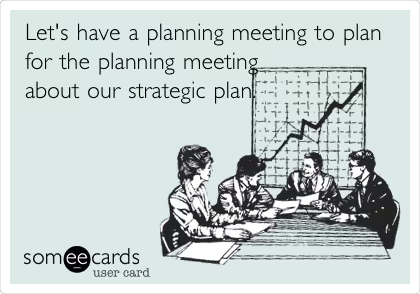
Guide decision-making with good strategies
Frame your strategy as choices. The company’s direction must be clear enough that it educates your people’s decisions when they reach crossroads. And they reach crossroads multiple times per day.
Get rid of static tools
Refining your strategy faces massive friction without a dynamic tool. That means wasting time, losing peace of mind, and ultimately losing money. Cascade removes this friction from all the stages of your strategy refinement, from planning to reporting, and even aligning.
Leverage data analytics
Use data analytics to inform your strategy implementation decisions. Data analytics can help you to identify trends, opportunities, and potential roadblocks, and to make data-driven decisions that support your strategic goals.
👉How Cascade can help:
If you are struggling to discover insights because your data and metrics are scattered across multiple business and project management tools, Cascade will make your life easier.
By integrating your metrics into one centralized source of truth, you'll have access to all performance data in one place. This makes it simple to transform statistical information into actionable insights and compelling narratives with effective data storytelling.
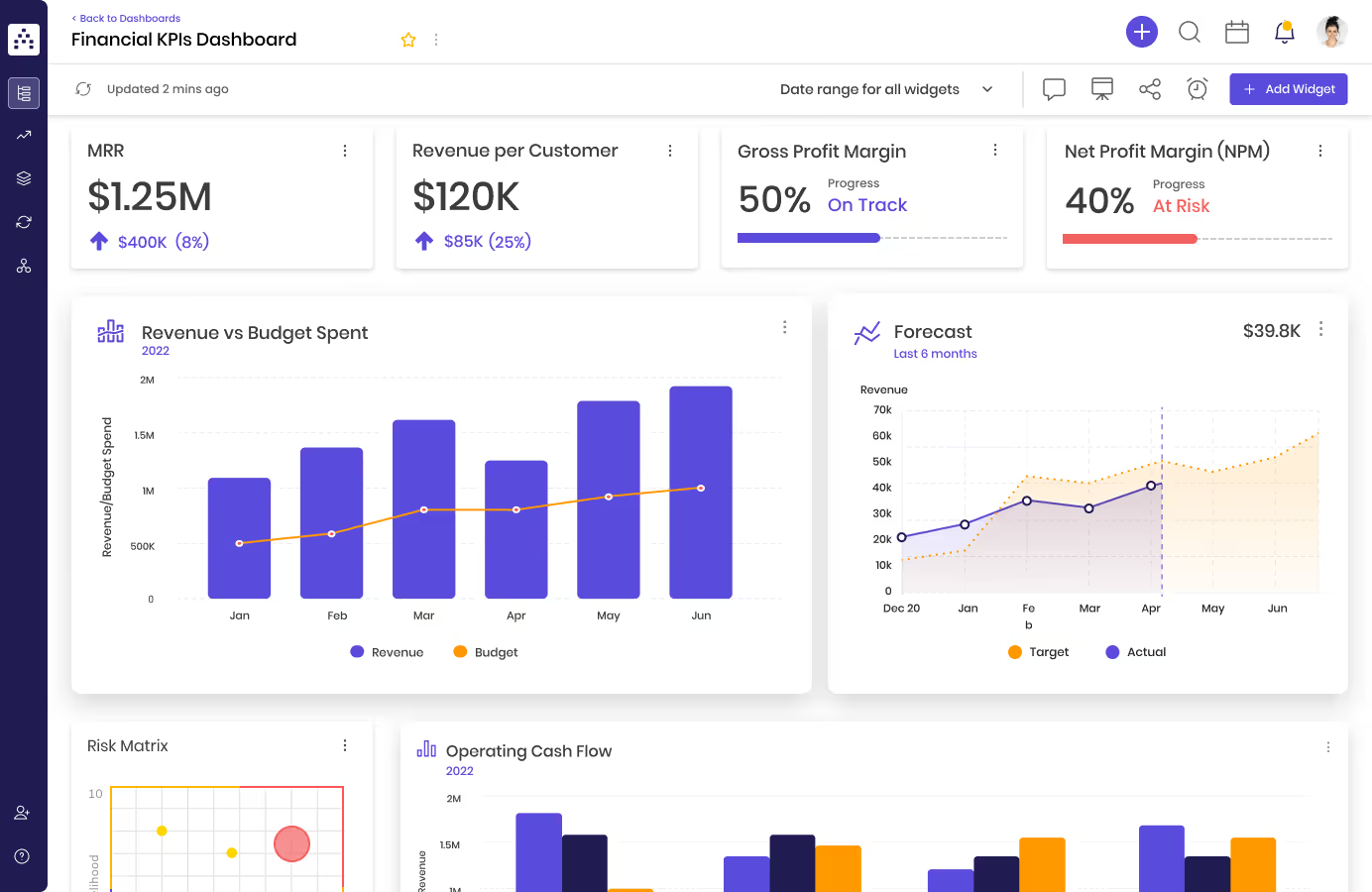
Cascade’s real-time dashboards are designed to help you monitor key sets of data or metrics in real time, giving you the visibility you need to stay on top of what's important.
And with customizable features, you can tailor your dashboard view to suit your needs, making it easy to share insights with your team and keep everyone aligned.
Follow these tips and best practices, and let Cascade help you bring your strategy implementation game to the next level.
📚 Recommended read: Best Strategy Software: 8 Possible Roads To Strategy Execution (2023)
Implement strategies with Cascade 🚀
Working your way through our 6-step process guide to strategy implementation isn't something you'll be able to do overnight. It will take a good few weeks and probably a few iterations. But don't let that be an excuse not to start.
We can tell you without question that when our customers follow the above process, their strategy implementation plan succeeds far more often than it fails. This is an integral component of effective strategic management and shouldn't be overlooked.
By incorporating Cascade into your strategy implementation process, you can simplify your approach and maximize your chances of success. With Cascade's real-time dashboards, centralized business data, and full visibility into performance, you can stay focused and mitigate risks to ensure long-term success.
So why not take the first step today and incorporate Cascade into your strategic management process?
Experience the power of Cascade for yourself by taking a tour of our platform or booking a 1:1 demo call with one of our in-house strategy experts.
Other Related Strategy Implementation Templates
- Program Implementation Plan Template
- IT Implementation Plan Template
- Project Implementation Plan Template
- Digital Transformation Plan Template
- Strategic Growth Plan Template
Strategy Implementation FAQs
What is the difference between strategy implementation and strategy formulation?
Strategy formulation is the process of developing a strategic plan, while strategy implementation is the process of executing that plan by coordinating and communicating with different departments and individuals.




.avif)
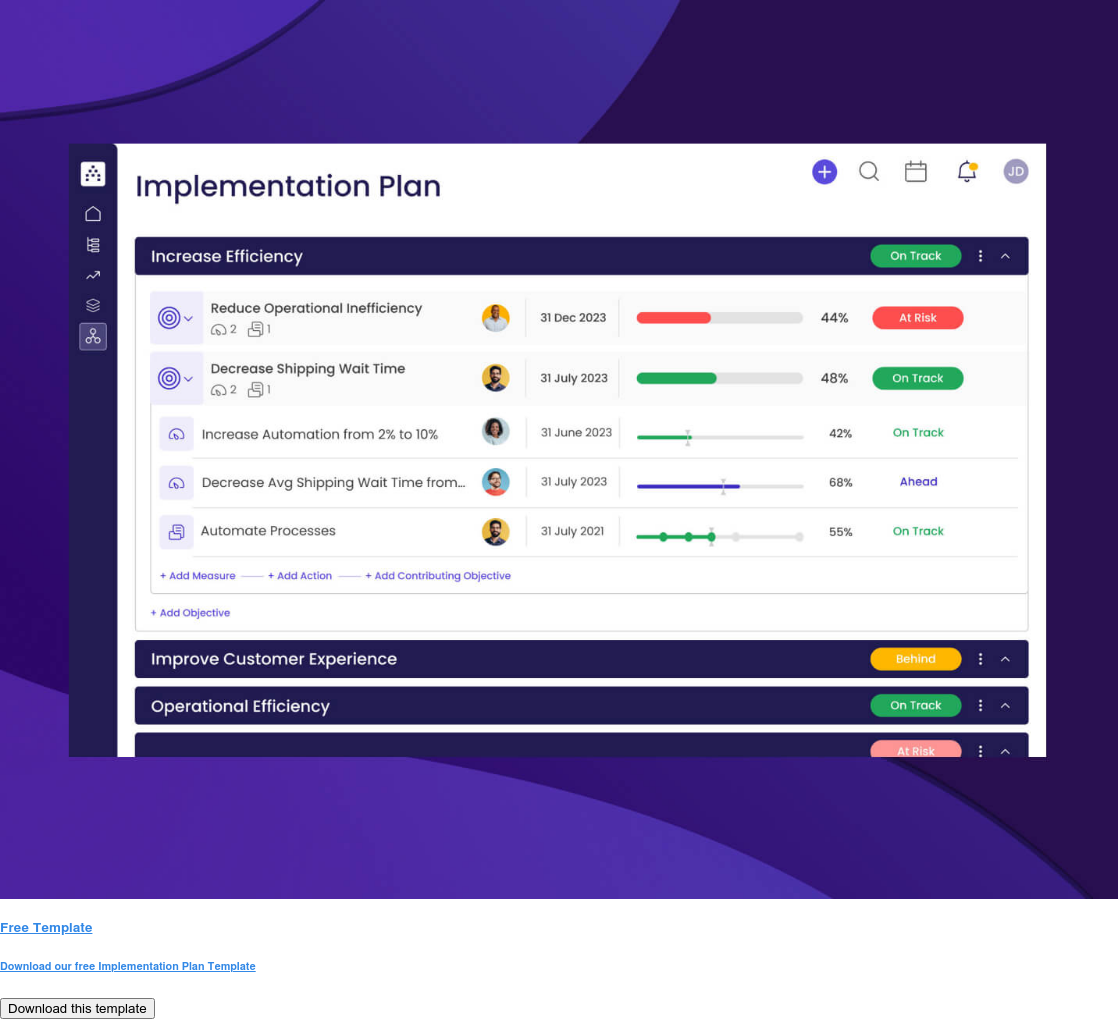

.png)
.jpg)
.jpg)



